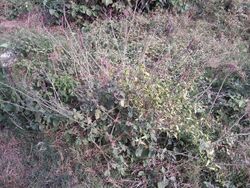Biology:Achyranthes aspera
| Achyranthes aspera | |
|---|---|

| |
| Scientific classification | |
| Script error: No such module "Taxobox ranks".: | Plantae |
| Script error: No such module "Taxobox ranks".: | Tracheophytes |
| Script error: No such module "Taxobox ranks".: | Angiosperms |
| Script error: No such module "Taxobox ranks".: | Eudicots |
| Script error: No such module "Taxobox ranks".: | Caryophyllales |
| Script error: No such module "Taxobox ranks".: | Amaranthaceae |
| Script error: No such module "Taxobox ranks".: | Achyranthes |
| Script error: No such module "Taxobox ranks".: | <div style="display:inline" class="script error: no such module "taxobox ranks".">A. aspera |
| Binomial name | |
| Achyranthes aspera | |
Achyranthes aspera (common names: chaff-flower,[1] prickly chaff flower,[2] devil's horsewhip,[3] Sanskrit: अपामार्ग apāmārga) is a species of plant in the family Amaranthaceae. It is distributed throughout the tropical world.[4] It can be found in many places growing as an introduced species and a common weed.[5] It is an invasive species in some areas, including many Pacific Islands environments.[6]
Description
- Habit : A wild, perennial, erect herb.
- Stem : Herbaceous but woody below, erect, branched, cylindrical, solid, angular, hairy, longitudinally striated, nodes and internodes are prominent, green but violet or pink at nodes.
- Leaves : Ramal and cauline, simple, exstipulate, opposite decussate, petiolate, ovate or obovate, entire, acute or acuminate, hairy all over, unicostate reticulate.
- Inflorescence : A spike with reflexed flowers arranged on long peduncle.
- Flowers :Bracteate , bracteolate , bracteoles two, shorter than perianth , dry, membranous and persistent, sessile, complete, hermaphrodite, actinomorphic , pentamerous, hypogynous, small, spinescent, green.
- Bracts ovate, persistent, awned.
- Perianth made up of 5 tepals, polyphyllous, imbricate or quincuncial, green, ovate to oblong, persistent.
- Androecium made up of 10 stamens, out of which 5 are fertile and 5 are scale-like, fimbriated, sterile staminodes, both alternating with each other, fertile stamens are antiphyllous, monadelphous, filaments slightly fused at the base, dithecous, dorsifixed or versatile, introrse.
- Gynoecium: it is bicarpellary, syncarpous, superior, unilocular, ovule one, basal placentation, style single and filiform, stigma capitate.
- Fruits : Oblong utricle
- Seeds : Endospermic with curved embryo, 2 mm long, oblong black.
- Flowering and Fruiting time : September to April
Significance
- It is very useful in dropsy, piles, boils and for colic in children. [citation needed]
- It is also used as a cure for cough. [citation needed]
Uses
The juice of this plant is a potent ingredient for a mixture of wall plaster, according to the Samarāṅgaṇa Sūtradhāra, which is a Sanskrit treatise dealing with Śilpaśāstra (Hindu precepts of art and construction).[7]
It is one of the 21 leaves used in the Ganesh Patra Pooja done regularly on Ganesh Chaturthi day.
Traditional medicine
A. aspera has been used in folk medicine in countries including Australia.[8]

The 1889 book The Useful Native Plants of Australia records that this plant was found "in all the tropical and sub-tropical regions of the old world. The herb is administered in India in cases of dropsy. The seeds are given in hydrophobia, and in cases of snake-bites, as well as in ophthalmia and cutaneous diseases. The flowering spikes, rubbed with a little sugar, are made into pills, and given internally to people bitten by mad dogs. The leaves, taken fresh and reduced to a pulp, are considered a good remedy when applied externally to the bites of scorpions. The ashes of the plant yield a considerable quantity of potash, which is used in washing clothes. The flowering spike has the reputation in India (Oude) of being a safeguard against scorpions, which it is believed to paralyse. (Drury.)"[8]
Chemical constituents
Achyranthes aspera contains triterpenoid saponins which possess oleanolic acid as the aglycone. Ecdysterone, an insect moulting hormone, and long chain alcohols are also found in Achyranthes aspera.[9]
References
- ↑ (xls) BSBI List 2007, Botanical Society of Britain and Ireland, https://bsbi.org/download/3542/, retrieved 2014-10-17
- ↑ Flowers of India
- ↑ USDA Plants Profile
- ↑ Flora of North America
- ↑ {{citation | mode = cs1 | title = Achyranthes aspera | work = Germplasm Resources Information Network (GRIN) | url = | publisher = [[Organization:Agricultural Research ServAgricultural Research Service (ARS), United States Department of Agriculture (USDA) | access-date = 2018-01-02 }}
- ↑ Pacific Islands Ecosystems at Risk
- ↑ Nardi, Isabella (2007). The Theory of Citrasutras in Indian Painting. Routledge. pp. 121. ISBN 978-1134165230.
- ↑ 8.0 8.1 J. H. Maiden (1889). The useful native plants of Australia : Including Tasmania. Turner and Henderson, Sydney. https://primo-slnsw.hosted.exlibrisgroup.com/primo-explore/fulldisplay?docid=SLNSW_ALMA21105097830002626&context=L&vid=SLNSW&search_scope=EEA&tab=default_tab&lang=en_US.
- ↑ Indian Herbal Pharmacopia Vol. II, Page-5.
External links
| Wikimedia Commons has media related to Achyranthes aspera. |
Wikidata ☰ Q3286822 entry
 |
